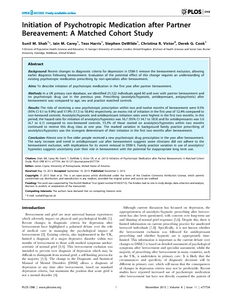Shah, SM; Carey, IM; Harris, T; DeWilde, S; Victor, CR; Cook, DG
(2013)
Initiation of Psychotropic Medication after Partner Bereavement: A Matched Cohort Study.
PLOS ONE, 8 (11).
e77734- e77734 (10).
ISSN 1932-6203
https://doi.org/10.1371/journal.pone.0077734
SGUL Authors: Carey, Iain Miller Cook, Derek Gordon De Wilde, Stephen Harris, Teresa Jane Shah, Sunil Mulji
![[img]](https://openaccess.sgul.ac.uk/103243/1.hassmallThumbnailVersion/pone.0077734.pdf)  Preview |
|
["document_typename_application/pdf; charset=binary" not defined]
Published Version
Download (577kB)
| Preview
|
Abstract
Background
Recent changes to diagnostic criteria for depression in DSM-5 remove the bereavement exclusion, allowing earlier diagnosis following bereavement. Evaluation of the potential effect of this change requires an understanding of existing psychotropic medication prescribing by non-specialists after bereavement.
Aims
To describe initiation of psychotropic medication in the first year after partner bereavement.
Methods
In a UK primary care database, we identified 21,122 individuals aged 60 and over with partner bereavement and no psychotropic drug use in the previous year. Prescribing (anxiolytic/hypnotic, antidepressant, antipsychotic) after bereavement was compared to age, sex and practice matched controls.
Results
The risks of receiving a new psychotropic prescription within two and twelve months of bereavement were 9.5% (95% CI 9.1 to 9.9%) and 17.9% (17.3 to 18.4%) respectively; an excess risk of initiation in the first year of 12.4% compared to non-bereaved controls. Anxiolytic/hypnotic and antidepressant initiation rates were highest in the first two months. In this period, the hazard ratio for initiation of anxiolytics/hypnotics was 16.7 (95% CI 14.7 to 18.9) and for antidepressants was 5.6 (4.7 to 6.7) compared to non-bereaved controls. 13.3% of those started on anxiolytics/hypnotics within two months continued to receive this drug class at one year. The marked variation in background family practice prescribing of anxiolytics/hypnotics was the strongest determinant of their initiation in the first two months after bereavement.
Conclusion
Almost one in five older people received a new psychotropic drug prescription in the year after bereavement. The early increase and trend in antidepressant use after bereavement suggests some clinicians did not adhere to the bereavement exclusion, with implications for its recent removal in DSM-5. Family practice variation in use of anxiolytics/hypnotics suggests uncertainty over their role in bereavement with the potential for inappropriate long term use.
| Item Type: |
Article
|
| Additional Information: |
Copyright notice
This is an open-access article distributed under the terms of the Creative Commons Attribution License, which permits unrestricted use, distribution, and reproduction in any medium, provided the original author and source are credited. |
| Keywords: |
Science & Technology, Multidisciplinary Sciences, Science & Technology - Other Topics, MULTIDISCIPLINARY SCIENCES, OLDER-PEOPLE, HEALTH, DSM-5, DEPRESSION, VALIDATION, EXCLUSION, DATABASE |
| SGUL Research Institute / Research Centre: |
Academic Structure > Population Health Research Institute (INPH) |
| Journal or Publication Title: |
PLOS ONE |
| ISSN: |
1932-6203 |
| Related URLs: |
|
| PubMed ID: |
24223722 |
| Web of Science ID: |
24223722 |
  |
Download EPMC Full text (PDF)
|
 |
Download EPMC Full text (HTML)
|
 |
Go to PubMed abstract |
| URI: |
https://openaccess.sgul.ac.uk/id/eprint/103243 |
| Publisher's version: |
https://doi.org/10.1371/journal.pone.0077734 |
Statistics
Item downloaded times since 02 Apr 2014.
Actions (login required)
 |
Edit Item |




